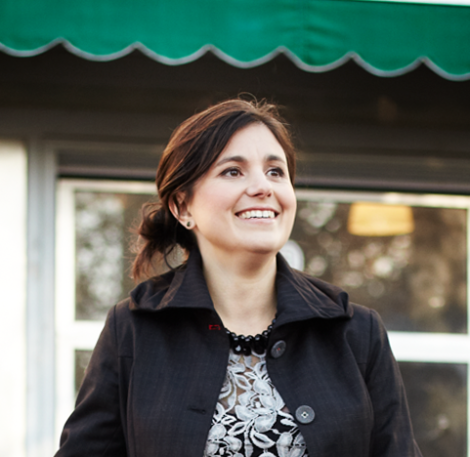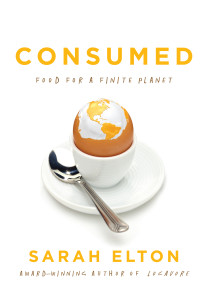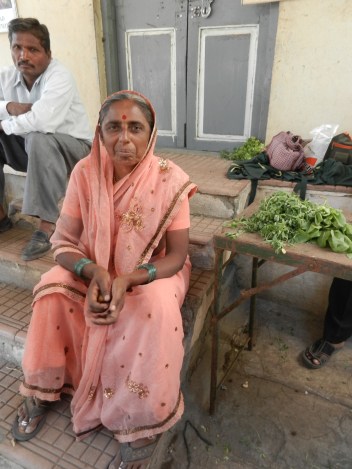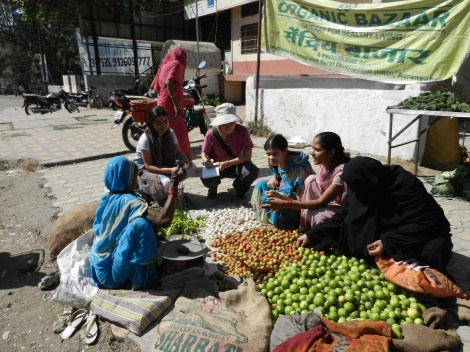How do we feed ourselves without laying waste to the earth, and ruining everything for the next generation? If you think about it, that’s the existential question for humanity. (As opposed to, say, should I use the Oxford comma? What’s the air-speed velocity of an unladen swallow? And do I wear boxers or briefs?) And it is the question that journalist Sarah Elton tackles in her new book, Consumed: Food for a Finite Planet.
Elton wants a food system that allows us to do more than just feed ourselves: She wants agriculture that will allow people and the environment to thrive. In reporting Consumed, she traveled around the world, talking to farmers and scientists, to get a sense of what might really work. We corresponded via email. (And oh, the answers to those other existential questions are, of course: yes; 42; and both, layered.)

Sarah Elton.
NJ It’s not universally accepted that what most people think of as sustainable agriculture — that is, small, organic, biodiverse — is actually sustainable. As you point out there’s a good argument to be made that big, highly efficient, industrial food production systems can feed more people while doing less damage to the earth. But after looking unblinkingly at that argument — and its associated science — you remain steadfastly on the side of organics. What was the evidence that convinced you?
SE I wrote this book because I wanted to be able to answer this very question — with confidence. I kept meeting people who would ask me, as a journalist who covers food and the environment, whether the big, efficient food production of the industrial system was in fact more sustainable. And what I found when I dug into the issue was that there are a lot of myths about industrial food production that overshadow its known problems.
When you look at the facts, the status quo is just not sustainable. The way we produce food today drains ground water aquifers. It pollutes surface water, ground water, and oceans with chemical and fertilizer runoff. Over the last 100 years, it has diminished biodiversity dramatically. And the food system today is deeply reliant on fossil fuels — while also producing so many greenhouse gas emissions (think industrial livestock production that is responsible for 14-18 percent of emissions — estimates vary).
A system like this simply cannot be called sustainable if it is destroying the very things — like clean water, healthy soil, biodiversity — it needs to keep producing food for our kids and their grandkids. Not to mention worsening climate change.
What’s the alternative? Agriculture that nurtures biodiversity from the bees to the seeds to the nematodes in the soil, conserves water, manages nutrients in fertilizer responsibly, that sequesters carbon. When I traveled around the world researching this book, I found that these signposts of sustainability were more likely to be found on small farms, practicing sustainable — organic — agriculture. Also, if you look at the science, organic soils are more able to sequester carbon as well as more resilient to the extreme weather events that scientists say will become increasingly common with climate change.
Farmers who practice this kind of agriculture were typically part of this global sustainable food movement that I write about in the book. And what was really interesting to see was that people who were farming in this way tended to be improving their fortunes — not getting poorer or hungrier. So this is true sustainability when it stretches from environmental sustainability to economic sustainability for farmers.
NJ I want to dig deeper into these points: I suspect that a lot of the Grist readers who have been considering this question will want a little more meat to determine how seriously you took your research on this. You cite a few reports: this one, from the United Nation’s special rapporteur on the right to food, which called for the expansion of agroecology; and this report from the National Research Council, suggesting that we need to develop “new farming systems that represent a dramatic departure from the dominant systems of present-day American agriculture.” You point to studies that suggest that small farms yield more per acre than large ones, and when I looked into this I found others that say small farms are important for fighting poverty.
But you also cite studies showing that organic farms tend to produce less food than conventional — though under some conditions they come very close! You quote the environmental studies professor Jules Pretty as saying, “Pure organic is not going to feed the world. Pure high-end biotech is not going to feed the world. It’s a combination of all applications.” Which means doing some non-organic things like using some synthetic fertilizers when it’s appropriate.
So correct me if I’m wrong here, but it sounds like you see the good techniques on small organic farms as just a starting place. And, while you are calling for a change in the food status quo, you aren’t really calling for the world’s farmers to convert to the current conception of “pure organic.” Anything you’d add to that?
SE What I found when I was researching was that figuring out how to feed our global population given all the problems — climate change, poverty, unequal access to infrastructure and technology, different soil conditions, environmental degradation, colonialism, etc., I could go on — in a sustainable way is really, really complicated. Also, we don’t know what sustainable means because we haven’t spent any time thinking about sustainability or invested R&D in anything other than the big industrial mega machine that is the global food status quo. We do know, however, that industrial agriculture is causing a whole lot of damage to our planet and our atmosphere.
The yield question is key because if the land we have in production doesn’t yield enough food, then we would need to bring more land into production by cutting down trees and probably taking over biodiverse areas. It’s the whole spare versus share conversation. So I wanted to look to the data to help answer whether or not organic yields can compete with conventional yields. Research out of McGill University, that was published in the journal Nature in 2012, took the data from 125 scientific studies to compare organic and conventional yields and found that there isn’t a definite answer. It depends on the crop, on the soil type, the farming practices. Legume crops happen to yield very well under organic production whereas conventional cereal crops tend to produce higher yields than organic.
However, I think it’s easy to get bogged down in the minutiae of the yield debate and forget that there is an important bigger-picture context. And that is the fact that, for the past decades, all our research money and private sector investment has gone into developing a more efficient and productive industrial food system. Government subsidies and support have gone into this system too. Organic has been neglected. Really, it’s amazing that organic agriculture is almost as productive as conventional in some instances — and equally or more productive in other contexts. Now that’s big news! Imagine if we as a society realized that our industrial food system bore too much of an environmental burden and we started to divert all our talent and money and research towards building a truly sustainable food system.
The reason people like Jules Pretty say that pure organics aren’t going to feed the world goes back to context. There are some places where the soil is so nutrient-deficient that a little fossil-fuel-produced fertilizer does wonders for food security and production. Whereas we use so much of the stuff to grow cash crops, such as corn, that the fertilizers runs off the fields and pollute water systems. We can build more sustainable food systems by tailoring production methods to context.
And there’s not a developing world versus developed world split, either. The women farmers I write about in India farm a very arid area where they happen to fare better by going organic. They told me that once they abandoned chemical farming, their soil improved, their plants’ health improved and their yields went up.
NJ There was a term I really liked that you got from the scientist (and newly minted MacArthur genius) David Lobell: He talks about being “adaptation agnostic.” That is, you decide what your goals are — like allowing people to feed themselves, ending poverty, cutting greenhouse gas emissions — and then you should be totally agnostic about how you get there: If it’s looking like your favorite technique isn’t working you cast it aside. I suspect this would mean breaking some of the rough definitions we’ve made about what constitutes good farming and bad farming. Do you agree? And do you have a sense of what sustainable farming might look like in the future? No synthetic fertilizer and pesticides, or precision use of these chemicals?
SE I love that term too. The climate crisis demands this of us! We must shed ideology and work together as a species to fix this mess that we’ve created. Lobell used the term in a different context, but when I called him up, he agreed that adaptation agnostic could be applied to the food context too. I tried to apply this frame of mind to my research and writing of this book.
There’s so much judgement when it comes to food — as you say, bad farming versus good farming. And it extends all the way to the table. I’m a mom and I have felt other people’s judgement of what I feed my kids — bad food versus good food. To create truly sustainable food systems, we will have to shed ideology and, as Lobell says, be agnostic in our evaluations of what works. But yes, I do have a sense of what sustainable farming might look like in the future. That is, farms where the nutrients and pests are managed responsibly, where water is conserved, where biodiversity is nurtured, where wilderness is spared, where farmers can earn a decent living and where government policy supports sustainability.
If there’s a massive outbreak of disease that threatens a farm, maybe a farmer would have to use chemical pesticides because that’s the most effective way to treat a problem. Maybe the farmer won’t. But, following Lobell’s advice, if a farmer is able to evaluate the data with this agnostic mindset, then hopefully the decision will weigh the costs and benefits of using this technology rather than abusing it by overuse or automatic, unthinking use.

Organic farmer Chandrakala Bobane.
NJ One thing that struck me a couple times in reading your book was that the positive examples you gave were farmers producing food that they could sell for more money. On the flip side, that also means more expensive food. You make a good argument that somewhat more expensive food can be a good thing for our common wealth in the long run if it lifts farmers out of poverty and begins powering a robust regional economy. But in the short run — and I’m thinking here of the Indian farmer you describe, Chandrakala Bobane — it looks like the small organic farmers are simply serving the affluent and leaving the poor behind. We certainly hear that complaint about organic food being elitist here in America all the time. My question is, when does that transition happen? How do we construct food economies so that they really are spreading the wealth, rather than just providing a luxury to elites?
SE I witnessed firsthand in India that the organic food produced by the Mahagreen Producer Company wasn’t elitist. The people who shopped at the Organic Bazaar, where Chandrakalabai sells her food were the same kinds of people who would be at the conventional bazaar — that’s what the people I interviewed who lived in and around Aurangabad told me repeatedly. And when I compared the prices of a few items in the two bazaars, I found them to be the same. It was at the supermarket where prices were highest. Also, a number of the women I interviewed described selling their organic produce to their neighbors in the villages. So they supplied their organic food to the villages too. These are not affluent places.
But yes, in America the impression is that organic kale is for people who shop at Whole Foods and the rest of the population can only afford cheap, industrial fare. There is truth in this. That’s why people say we have a two-tiered food system — one for the rich, one for the poor.
There’s a two-part answer to your questions. I’ll start with the countryside. In rural areas, local food economies enrich the community in general, thanks to something called the multiplier effect — an increase in spending that causes an increase in income and consumption that is greater than the initial amount spent. (Back in 2006, Yes Magazine made a great visual explanation of this effect.) When you ask about transition, the transition to a healthier food system and economy takes place when farmers are embedded in their regional food systems, selling through CSAs, co-operatives, to restaurants and other direct sales arrangements where they can capture more of the food dollar. The dollars circulate, spreading the wealth. This is why rural regions in the U.S. and beyond are looking to nurturing local food economies to bring life back to areas that have been emptied of jobs and population.
In cities, it’s the local food movement that is at the fore of making sure sustainable food systems feed the people who don’t shop at Whole Foods. It’s the local food movement that is opening urban farms in urban food deserts — places where the industrial food system has deemed that it isn’t worth it to sell fresh fruit and vegetables period or where they are not affordable. There are dozens and dozens of nonprofit organizations and charities that are working in America to get healthy and affordable fruits and vegetables to people in cities by creating sustainable food systems. A second transition point would be a critical mass of such not-for-profit programs and social enterprises that bring sustainable foods to urban people who previously only had so-called cheap industrial food to choose — at best.

Sarah Elton interviewing women at an organic bazaar in India.
NJ OK, so let’s say we are all convinced that we need sustainable ag systems, that feed both the people and the local economy, support farmers, heal the environment, and make a lot of delicious food. I mean — that has to sound pretty great to most of us. So how do we make it happen? What are the first steps a community needs to take to form that kind of vibrant regional food system?
SE That’s what’s had me scratching my head for the last few years. Sustainable food systems that are rooted in local economies have so many terrific benefits. So why aren’t we moving more quickly in this direction? I think the key step to making this happen is government. We see civil society coming up with all sorts of amazing, innovative solutions — their stories are the focus of the book — but they really need government support to scale up, to ensure their long-term survival (such as when land tenure is an issue), and even to offer financial support.
There’s a lot of talk in the sustainable food movement about social enterprises and figuring out ways for innovative food programs to pay for themselves, but commodity corn farmers get a whole lot of government support. So too should the sustainable farmers and food system builders. And this, of course, leads us into a big discussion of subsidy reform and vested interests and lobby groups and big food and suddenly it makes sense as to why our governments aren’t chasing the benefits of sustainable food systems.
NJ Anything else you want to slip in?
SE When you look at the big picture, the possibility of sustainable food systems can feel very distant. And while researching this book, I met people who have devoted their lives to creating working solutions who feel very discouraged.
I was in a taxi in Beijing one dark night with a professor who had helped a rice-growing village become self-sufficient, rather than being dependent on sending away their family members to work in the factories to earn a living. She’d hooked the farmers up with consumers in the city who would pay more for their organic rice than they could get selling wholesale. But she felt defeated. She said to me that her work in the grand scheme was very small. Because there were thousands of other villages in China that remained dependent on manufacturing income rather than sustainable farming.
And she had a point. If you see each tiny effort in isolation, then they each feel so small in the face of the behemoth of the industrial food system. However, if you take all these efforts together, then a global social movement takes shape. And global social movements have the power to make real change. This is how we can find hope that our kids and our grandkids will have a food system that works for them, for the earth, and for the future.



